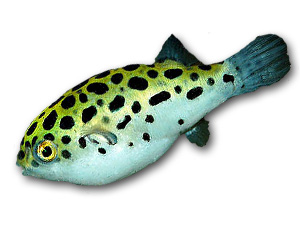Green Spotted Puffer

Quick Stats
| Size | Up to 6.75" (17cm) |
|---|---|
| Tank | 180 Litres |
| Swimming Area | Bottom, middle |
| Ph | 7.5 to 8.5 |
| Temperature | 75ºF to 82ºF (24 - 28°C) |
| Food | Flaked, live or frozen |
Common Name:
Green Spotted Puffer.
Distribution:
Tropical Eastern Asia, from then coastal regions of Indochina and the Philippines to India. Found in fresh and brackish waters.
Colouration:
The color is variable depending on age and the origin of the fish. In mature specimens the top and head area is marked with large Brown or Black spots. The spots on the side are smaller and also round in shape. The body color between the spots is a beautiful Emerald Green color which makes a nice contrast to the dark spots. The bright Green color is subdued in younger specimens. The fins are semi transparent with a slight Yellow tint to them.
Lifespan:
Up to 20 years.
Maintenance:
10 to 20% weekly. Most puffers are undemanding in their care and many of the Brackish species can be acclimated to hard, alkaline water fresh water. They are best kept singly or with other large tough fish.
Feeding:
They are not hard to feed and usually will accept all types of flake, frozen and live food. In the wild they feed on small mollusks and invertebrates.
Substrate:
Preferably sand.
Tank Decor:
The tank setup should contain plants and rockwork for hiding as well as open areas for swimming.
Filtration:
Standard filtration for the size of the tank. Not too much current.
Biotype:
A coastal area brackish setup.
Breeding:
Not a lot is known of their breeding and it probably can only be accomplished in Brackish water. During courtship the pair will swim around each other just above the bottom of the tank. Pale clear eggs are laid tightly packed on rock surfaces. The male will protect the brood and uses his body to cover the eggs. The eggs hatch in about a week and the male will transfer the tadpole like fry to shallow pits and continue to guard them. The fry can be hard to raise and feeding them can be difficult, you should try a variety of small food including Brine shrimp nauplii and observe which type they are eating. The mortality rate on the spawn is usually high.